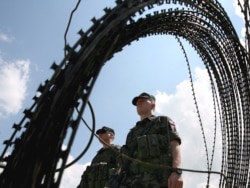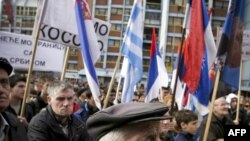Oliver Ivanovic, who currently serves as a key Belgrade official on Kosovo issues, was born in Mitrovica. But he says even he finds the city to be neglected and dreary.
"In this gloomy, gray atmosphere, it's hard to be an optimist," Ivanovic says. "People who were born here and have lived here for a long time have become attached to this town. But talking to them, I learned that, despite their roots in Mitrovica, some of them have reached the conclusion that this is no longer the place they used to care about. They're thinking about leaving."
Mitrovica, in northern Kosovo, has been a divided city for nearly a decade. Its northern half, and its environs, are home to the bulk of Kosovo's 250,000 ethnic Serbs. Contact is rare -- and often hostile -- with the majority Albanians who populate the city's southern half.
Diplomacy, Not Violence
As Kosovo marks its first anniversary as an independent state, many see the divided city as a living emblem of the ethnic and historic tensions that continue to threaten the fragile peace in the former Serbian province.
Serbia continues to reject Kosovo's independence, and has encouraged Kosovo Serbs in Mitrovica and elsewhere to do the same. But at the same time, Belgrade has vowed to use diplomacy -- not violence -- in its relations with Pristina, and the year that has followed Kosovo's declaration has been largely peaceful.
Ivanovic is among the moderate Serbian politicians who has only recently returned to active policymaking after years on the margins during the tenure of former Prime Minister Vojislav Kostunica, who was known for his firm, right-wing policy on Kosovo.
But Ivanovic returned to government under the new prime minister, Mirko Cvetkovic, and now serves as state secretary for Serbia's Ministry for Kosovo and Metohija, as Kosovo is officially known in Belgrade.
Belgrade's subtle shift on Kosovo is credited to officials like Ivanovic, whose success has been seen as a warning to hard-line authorities running the show in North Mitrovica, like Marko Jaksic.
Jaksic is the leader of the Association of Serbian Municipalities, which has invited parliament deputies from Serbia proper to hold an assembly on February 17 in the Kosovar town of Zvecani. The move is widely seen as a gesture of protest on a day when Kosovo's Albanian majority will be celebrating the country's first year of independence.
Ties to Serbia still reign supreme in North Mitrovica, and the mere mention of Jaksic -- a close ally of Kostunica -- is enough to open doors in the city. A local priest, Milivoje Arsovic, agrees to speak to a reporter only after being told the journalist was sent with Jaksic's personal blessing.
Arsovic runs the Church of St. Dmitri, which was built three years ago on a hill perched above the city. From the church grounds, one can look down and see the remains of Albanian houses burned down during the 1998-99 Kosovo war. The priest hastens to add that many Serbs suffered, as well.
"You want to know about the houses that were burned down?" Arsovic asks. "Well, some Serbian houses were burned down as well. But we're rarely asked questions about that, and yet 250,000 Serbs were expelled. So it means that there were problems on both sides."
Near-Constant Tensions
Mitrovica, unfortunately, remains a city of near-constant tensions and violence. Window-rattling explosions could be heard during the night of February 15, as North Mitrovica residents were celebrating Serbian Statehood Day.
"A bomb went off in Mitrovica yesterday," one young man said, "and my parents called to check up on me about 30 times, like it was an atomic explosion. The feeling of fear is constant."
"People here are used to explosions," one man says. "So, as you can see, one day there's a bomb and the next people are just walking around normally."
"Everyone feels the threat, but it's worst for our young people," one older man says. "They live under constant stress. I'd trade places with anyone in the [Serbian] towns of Kragujevac or Kraljevo. They can sleep soundly at night without having to worry what morning will bring."
Apart from the natural division created by the Ibar, North Mitrovica itself is being further divided between a Serbian section of the city and three neighborhoods -- Bosnjacka Mahala, Tri Solitera, and Suvi Do -- that are largely Albanian.
'My Presence Is A Provocation'
Bajram Rexhepi, the first postwar prime minister of Kosovo and now the mayor of South Mitrovica, lives in Suvi Do, in a house that was burned to the ground and rebuilt after 1999. Redzepi was asked whether he dared to walk through the Serbian half of the city.
"They would see my presence as a provocation. I don't think that anyone would dare to attack me. But other people might be attacked because of my presence. That's happened in the past," Rexhepi says.
"That's why I'm doing my best not to be provocative. I'm not afraid to go there, and I don't think [Serbs] would dare do anything. But an innocent person could come under fire because of me, so I avoid it," he adds.
Rexhepi is not alone. Bosnjacka Mahala, the site of regular clashes and violence, is home to Albanian students like Gzim Rahova.
Rahova has spent the past 10 years as a refugee in the Albanian neighborhood, living just dozens of meters away from his real home in an apartment building in what is now a Serbian district.
Expelled as a teenager, he is now not even allowed to enter the region where his family home sits, abandoned, within view of where he lives now.
"My flat is 100 meters away -- and for 10 years I haven't been able to go home. I've watched it all this time. Why can't I go there? Did I do anything wrong? Did I kill anyone? No," Rahova says. "When the war started, I was 16 years old and didn't do anyone any harm. But I'm not allowed to go there, and it's just 100 meters away. I can see my balcony from this distance."
'It's Not Safe'
There are similar stories on the Serbian side.
Vuk Mitrovic is a student at Mitrovica University -- an institution that younger locals laughingly refer to as "Harvard on the Ibar." He says he no longer has the courage to cross over into the Albanian parts of town.
"Recently I was in Bosnjacka Mahala, and I really felt afraid. It's not safe there," Mitrovic says. "Bosjnacka Mahala and Tri Solitera are places where most of the incidents are taking place. It's not safe."
Most car owners in Mitrovica now carry two sets of license plates -- one Kosovar, one Serbian -- that can be easily exchanged, depending on what part of the city the person happens to be driving in.
Albanians and Serbs alike have been known to vandalize cars carrying the "wrong" plates -- a practice that speaks volumes about the atmosphere in a city that seems to sink further into depression and fear with each passing day.
The Divided City Of Mitrovica

The Divided City Of Mitrovica
Kosovo celebrated its declaration of independence on February 17, 2008. But that historic moment did little to resolve the ethnic tensions in the northern town of Mitrovica, which remains divided between ethnic Albanians and Serbs. Play















